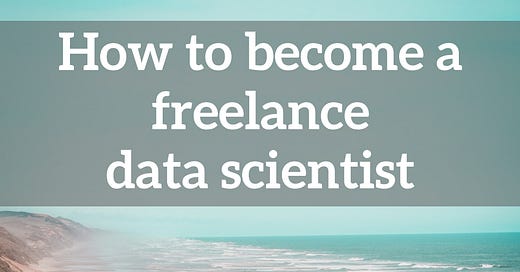Embarking on the freelance path, Robust AI and Reinforcement Learning
Dear friends,
In recent years we have seen a rapid raise in Machine Learning jobs. Companies need these professionals to leverage their proprietary data, and stay ahead of the competition.
Most ML professionals go for 9-5+ jobs, and they trade 50 hours a week for a good-to-great salary.
I used to work like that.
After 7 years of working on 2 different 9-5+ jobs, I realized that I was terribly underpricing my time, and my learning had plateaued.
So, I quit.
I had heard of freelancing as a way of earning a living, but I was a bit lost. I had lots of unanswered questions:
How can I find clients?
How can I showcase and prove I can help them, and get the project?
How should I price my services? How much should I charge?
What about interviews, how should I prepare for them?
Becoming a freelancer is challenging and full of mental hurdles. This is why most people still work (and live) in the 9-5 world.
However, the perks are great, including:
higher learning speed, as you are constantly taking in new projects and working with different technologies.
opportunity to work with cutting-edge startups, without having to leave in a small room in San Francisco.
freedom to organize your days, weeks, and months, plus no one is counting how many vacation days you have taken off this year.
higher hourly rates, which translate into higher paychecks at the end of the month
Looking back, I am very happy I took this new direction in my work and life. And I am sure most of you would do as well.
Because of this, I have created my new eBook: “How to become a freelance data scientist", a 5-step process that will help you become a freelancer.
It is completely FREE, and you can download it right now.
Feel free to reach out, and let me know about your experience trying to become a freelancer. I would love to hear your thoughts.
Till then, I wish you a happy and productive week.
Keep on (m)learning! And freelancing!
Pau
Other resources
The gap between research and robust AI
Would you say Deep Learning models have become so good, that robust AI systems are no longer a dream, but a reality?
Do you think you can safely use the latest models published by researchers in any real-world problem, like self-driving cars? Or face recognition software at airports?
Convinced that machines are already better than humans at processing and understanding images?
I was too. Until I realized it is possible to deceive a state-of-the-art model, like DeepMind Perceiver, with a few lines of code.
In this article, I will show you how you can do that in less than 10 minutes through a hands-on example. On the way, we will understand what are the implications of this example on real-world safe and robust AI
👉🏽 The gap between research and robust AI
The Hands-on Reinforcement Learning course
I am currently preparing lesson 8 of the Hands-on Reinforcement Learning course. If you have followed the course so far, thank you, and excuse me for the delay. When you build RL agents from scratch, lots of things can go wrong.
If you are interested in learning reinforcement learning you can get started right now, with part 1 of the course.






